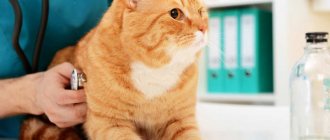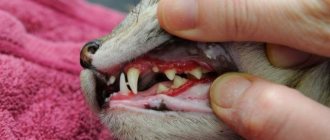Skin diseases are a common occurrence in domestic and farm animals. Pathologies manifest themselves in different ways: hair loss due to attack by parasites, problems with the epidermis and internal disorders. The causes of these symptoms need to be accurately determined. The veterinarian will not only identify the disease, but also prescribe the correct treatment. Some skin diseases can be dangerous to your pet's health.
Causes of sores throughout the body in cats
Damage to the skin is caused by sources of various types. These may be hereditary, infectious or anthropogenic (man-made) factors. The condition of the skin is affected by food changes, poor water quality, or even stress caused by moving to a new place of residence. Scabs, ulcers, and small wounds progress quickly without timely treatment. They cause the pet great discomfort and pain. The cat becomes nervous, scratching the affected areas.
Some ailments do not have obvious manifestations. It is possible to notice pathology only with a thorough examination of the animal. The most obvious is refusal to eat, apathetic state, and constant scratching. The wounds can be of different shapes and colors. They have one thing in common - this is an external manifestation of a serious internal disease.
The main factors may be:
- poor nutrition;
- genetics;
- allergies;
- bacterial and fungal infections;
- blood-sucking or intestinal parasites: ticks, fleas, worms;
- weak immune system.
This diversity means that pathology may well occur in almost any mustachioed friend. There are many specific reasons for this. A specialist in a veterinary clinic can find out the cause of the appearance of ulcers, wounds or scabs, as well as select the correct therapy.
Fungal dermatitis
Fold cats are predisposed to Malassezia otitis.
The yeast fungus Malassezia is a permanent inhabitant of the cat's skin. In individuals with immunity weakened by the underlying disease, when kept in conditions of heat and high humidity, yeast begins to multiply.
The ear canal is affected. The cat scratches the itchy area, the ichor comes out, dries out, and crusts form. Fold-eared cats are predisposed, as are pets with large ears. Treatment is prescribed by a veterinarian. These are drugs that eliminate the underlying disease, external or systemic antimycotics.
Be sure to read:
What is the reason and what to do if a cat’s claws peel off?
Prevention involves regular ear cleaning.
Diseases with skin lesions
It is worth taking a closer look at the health problems that cause the uncharacteristic appearance of the skin and coat. Each illness negatively affects the external and internal condition of the pet.
Bacterial and fungal infections
Infections with pathogenic organisms occur in different ways. For example, the dry type of infection causes the appearance of dry, compacted crusts on the surface of the body. The wet form is characterized by redness, ulcers, scratching and severe itching. The reasons for the penetration of infections are varied:
- metabolic disorder;
- diabetes;
- neoplasms of various types;
- weakened immune system;
- superficial wounds.
Treatment is carried out only by a veterinarian after a thorough examination and laboratory tests. One of the most unpleasant and contagious lesions is lichen, which is transmitted to other animals and humans.
It is impossible to choose on your own how to treat a cat’s scratching: to do this, you need to determine the type of pathogen. This can only be done in a veterinary clinic laboratory.
Parasites in cats
One of the most common causes of wounds on a pet’s body is parasites that choose warm areas on its surface. For example, the neck and axillary parts are very attractive to them. Parasites are external blood-sucking pests - fleas or mites, including scabies).
It is not the fleas themselves that cause discomfort, but the products of their activity. The saliva released when a wound is bitten contributes to the onset of allergic irritations. The pet scratches in this area due to severe itching. This is how pathogenic microorganisms appear in the wound, which trigger complications of the disease.
Skin pests are easy to spot. To do this, you just need to examine the body and head of your mustachioed friend. If parasites appear, it is necessary to carry out timely treatment to stop the spread of the infection. In any case, it is important to consult a veterinarian. He will examine the patient and determine that the appearance of sores in the cat is indeed associated with bloodsuckers.
Ticks are much more difficult to see. Subcutaneous individuals are found only by a doctor after a thorough examination and special tests. Treatment is most often prescribed in the form of drops on the withers or tablets. The drug "Ivermek", which is used as intramuscular injections, has proven itself well. The course of injections is 30 days, during which 3 vaccinations are given with a medicinal solution.
A similar product can also be purchased in the form of an ointment or gel. It is applied to the damaged surface after consultation with a veterinarian. Do this at home strictly according to the instructions.
It is important to remember that fleas do not pose a direct threat to your pet's health, but scabies can lead to death. Ticks not only spread under the skin, but also parasitize internal organs, so it is important to start treatment as soon as possible.
Allergic manifestations in cats
Sometimes sores on a cat’s skin occur due to allergies to external irritants. For example, purchasing a new brand of industrial food can lead to malfunctions in the body, which will manifest itself in the form of skin pathologies. It is possible to determine the cause of such a reaction by visual inspection and conducting special tests to recognize the allergen.
In addition to food, the body can react to dust, chemicals or hygiene products. Even inhaling ordinary washing powder leads to unpleasant consequences. There are times when sensitive cats react to blooms. The test, performed in a hospital setting, will identify a group of foods or other substances that need to be removed from the pet. If this is not done, the cat will have to be constantly given medications.
Dermatitis in animals
There are different types of skin dermatitis. Some of them have no complications, while others lead to death if treatment is delayed. They can be both bacterial and fungal, and are also caused by mechanical damage.
The bacterial type of dermatitis manifests itself as ulcers on the body and head of the pet. Animals with weakened immune systems, as well as babies under 1 year old, are at risk of getting sick. Once the pathogen is identified, the doctor prescribes antibiotics.
Less dangerous, but just as unpleasant, are dermatitis caused by seborrhea or injury. In the first case, the cat develops dandruff, and the animal begins to constantly itch in different places. In the second case, a simple wound can fester and cause sepsis, which in many cases leads to death.
Acne on a cat's body
Acne is blackheads with hard crusts. Acne with the appearance of open and closed comedones is usually localized on the neck, chin and lips of the cat. The cause of acne is considered to be poor hygiene, infections, stress, and abnormalities in the sebaceous glands and hair follicles. Even low-quality plastic from which the bowl is made can cause acne. Contact with cheap material can cause unpleasant rashes - it all depends on the sensitivity of the individual.
Another symptom is slight hair loss. If the disease is not treated, ulcers, purulent pimples, inflammation, and bacterial infections appear. After making a diagnosis, the veterinarian prescribes antiseptic detergents: medicated shampoo, soap. In addition, lips, chin and other areas affected by acne are treated with Miramistin or Chlorhexidine.
Other lesions
Even psychogenic factors cause ulcers and crusts on a pet’s body. For example, Cushing's syndrome is manifested by baldness of certain areas of the skin. Fortunately, this syndrome is rare in pets: it appears due to too much of the hormone cortisol. The disease has other pronounced symptoms:
- strong thirst;
- frequent urination;
- constant feeling of hunger with subsequent enlargement of the abdomen;
- lethargy, muscle atrophy;
- thin skin, baldness.
Doctors often prescribe medications that can suppress large releases of cortisol into the blood. In severe cases, the pituitary gland, adrenal gland are surgically removed, or chemotherapy is used.
Another skin problem is alopecia. Loss of fur also occurs under the influence of neuroses. They can be caused by a change of place of residence, the appearance of a new owner, or meeting a new family member. Some breeds are most prone to pathology: these are Abyssinian, Himalayan and Siamese cats.
Baldness is focal. Most often it appears on the abdomen, groin area, sides or inner thighs. Sores rarely appear on a cat's neck. The medications Kot Bayun, Amitriptyline, and Stop-Stress help to cope with the problem.
Diagnostics
Before drawing up a treatment regimen, the doctor will conduct a series of diagnostic procedures. They are necessary in order to identify the causative agent of the disease:
- visual inspection of places with violation of the integrity of the cover;
- in case of baldness, a scraping is taken around the crust. The material is sent for microscopic examination;
- laboratory examination of the patient’s blood - general and detailed analysis;
- If there are seals in close proximity to the ears, an x-ray is taken. Neoplasm must be excluded.
When conducting diagnostics, you need to be extremely careful. A cat that is very bothered by the organ of hearing may begin to resist. After all, any touch to the affected area brings discomfort to the animal.
The danger of skin pathologies for humans
Despite the fact that such diseases are an unpleasant phenomenon, most of them are not transmitted to people. Timely and correct prescription of medications makes them not dangerous for their owners.
Infection with different types of lichen and allergic reactions from blood-sucking bites require the use of medications not only for the animal, but also for the owner. They do not pose a threat to life, but the spread of scabs and ulcers throughout the body of a person or pet is not a very pleasant phenomenon, and it needs prompt treatment.
Which clinics should I go to?
In Moscow, with the problem of crusts in the ears, you can contact most clinics. We will recommend the most proven ones.
Zoostatus Clinic on Warsaw Highway, 125 offers a full range of laboratory and dermatological tests. An initial appointment with a specialist dermatologist will cost the owners 2,100 rubles, and a cytological examination of scrapings will cost 900 rubles.
At the Biocontrol , an initial appointment with a dermatologist will cost 3,400 rubles, and scraping cytology will cost 1,000.
Of course, in less advertised and well-known clinics, the cost of treatment may differ significantly.
In St. Petersburg at the clinic named after. A. Fillmore at 154 Engels Avenue, scraping cytology will cost 1,000 rubles, and an appointment with a veterinary dermatologist will cost 1,700.
In any case, you will have to spend money on treating your pet. But we are responsible for those we have tamed!
Quantity
Share this post
Tweet
You may also like…
- Cat cleaning
Treatment of skin diseases in cats
Before visiting the hospital, you should prepare to answer questions about your mustachioed friend's condition. The doctor will definitely ask when the ulcers or scabs appeared and ask about diet and seasonal diseases. Having received complete information, the doctor will prescribe special tests and tests:
- biopsy;
- blood analysis;
- scrapings or smears;
- ultraviolet examination.
After laboratory tests, it will not be difficult to understand what caused the cat’s sores throughout the body. Often, a domestic cat is switched to a special diet containing mainly hypoallergenic foods. Vitamin and mineral complexes help restore the immune system. A course of antibiotics is most often accompanied by the use of probiotics to strengthen a weak body.
Sometimes medications can worsen a pet's condition. New symptoms or wounds begin to appear - this is an allergy to medications. In this case, the drugs are discontinued, and new medications are introduced with caution instead. The pet should be constantly monitored so as not to miss any unpleasant responses. If the cat’s condition has not worsened, then the course of therapy should be continued.
Most pet owners try to get rid of severe itching as quickly as possible. Indeed, if you eliminate this symptom, your pet will scratch the skin less and it will begin to heal. If scabs appear on the neck or head, a special collar is put on the animal. Eliminating itching without background therapy cannot be called the correct treatment, because it does not stop the root cause.
Buying medications on your own is strictly contraindicated, because this can lead to deterioration of health. Proper treatment promotes a quick recovery, and regular checks of the cat’s fur will be a good preventative measure against the spread of skin pathologies.
Bald spots on the paws and stomach: photos, causes, advice from veterinarians
A lot has been written here about feeding cats. He has already accumulated it both from old age and from improper feeding. I would remove boiled crucian carp and sausage from the table and choose medicinal professional premium food, or only in nature (but you have to weigh everything with a scale and cook it once a week). Our friends have a 14-year-old cat - the hair was peeling off from the ears and legs, itching until it bled - they fed it haphazardly, after they switched it to normal food, the cat came into divine shape. Here. My point is that animal nutrition is of primary importance for health. Everything is the same as with people.
Yanchik, put the cat on a diet, this is advisable. Try to replace the fish with boiled chicken, or lean beef. Fish, especially river fish, is not suitable for feeding cats, especially at this age. Try to remove sausages altogether, there are a lot of substances that are harmful to people, not just cats. Curdled milk, egg, low-fat cottage cheese, chicken, beef, chicken heart and gizzards, all boiled, but what am I telling you, read our threads about feeding natural and industrial feeds, choose what suits you. It is necessary to have blood analyzed and scraped for culture; without this, who will figure out what to treat the cat for. Consider age, this is also important, because an animal at that age needs, just like a person, a certain diet and care.
Thank you very much for the advice) we will definitely listen: smile:











